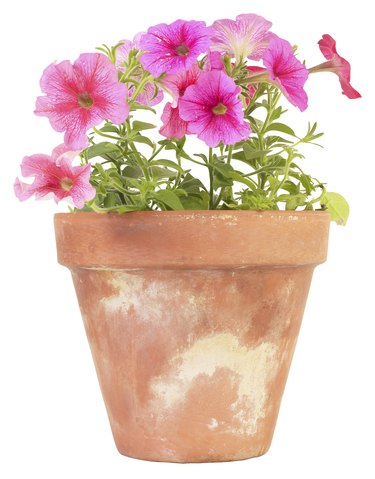
Petunias (Petunia x hybrida) are summer annuals with funnel-shaped or ruffled flowers that bloom from spring to first frost. With flowers of purple, pink, red, yellow or white, petunias fit in with many color schemes and look attractive in flowerbeds, containers, and hanging baskets. Petunias grow best in full sun to partial shade in evenly moist soil. Few pests bother petunias and the damage is usually not serious, so when you find black dots on your petunia leaves, chemical pesticides generally are not warranted.
Spreading Their Seeds
Video of the Day
Petunia leaves are slightly sticky and may hold plant seeds that drop onto them. The seeds may be from the petunia itself or from nearby plants. Some plants can throw their seeds a considerable distance. Other plants have lightweight seeds that are easily blown by the wind. Gently brush the seeds off the leaves and dispose of them in the trash, unless you can identify them and want to plant them.
Video of the Day
Small Black Aphids
Some aphids are black and can look like spots on petunia leaves. Aphids can also be brown, yellow, green or red. They have small, soft bodies, and some may have wings. They use their long, thin mouthparts to pierce plant parts and suck out sap. A few aphids usually do not cause a significant amount of damage. A severe infestation of aphids can cause stunted growth and yellow leaves. Aphids produce a sticky substance called honeydew, which attracts ants and promotes the growth of sooty mold. Wash aphids from plants with a mild stream of water, or a water and soap solution.
Budworms Drop Frass
Worms and caterpillars often leave small spots of excrement, called frass, on the foliage of petunias. The petunia budworm, also known as the geranium or tobacco budworm, often feeds on the buds and petals of the flowers. Damaged buds may not open, or the edges of open flowers may appear chewed and ragged. The damage from budworms is most noticeable in late summer. The color of budworms usually matches the color of the flowers they feed on, but they may also be green or brown. Handpick budworms from infested plants at dusk when they are most active.
Thrips Leave Feces
Small specks of excrement, usually around stippled areas on petunia leaves, are an indication of thrips. Western flower thrips are the most common variety on petunias. They feed in the flower buds and the curled new growth of foliage, which results in discoloration and distortion of the affected plant parts. Adult thrips are tiny insects with slender bodies and long, narrow, fringed wings. They may be black, brown, yellow, orangish or white. Immature thrips are yellowish to orangish, and do not have wings. Pesticides may reduce an infestation of thrips, but cannot completely get rid of them.
- University of California: Petunia
- Clemson Cooperative Extension: Petunia
- Colorado State University: Petunia
- University of Illinois: Petunia Pests
- Esbenshade's Garden Centers: Wave Petunia Plant Pointers
- University of California: Aphids
- Colorado State University: Tobacco (Geranium) Budworm
- University of California: Thrips